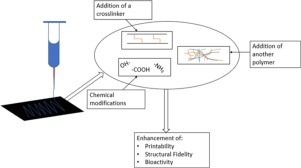Drug Discovery Today ( IF 6.5 ) Pub Date : 2018-09-19 , DOI: 10.1016/j.drudis.2018.09.012 Azraa Parak , Priyamvada Pradeep , Lisa C. du Toit , Pradeep Kumar , Yahya E. Choonara , Viness Pillay

|
3D bioprinting has emerged as the intersection between chemistry, biology and technology. Through its integration of cells, biocompatible materials and robotic-controlled dispensing systems, the process enables the production of structures that are biomimetic and functional, thus revolutionizing the concept of tissue engineering. One of the biggest limitations of 3D bioprinting for tissue engineering is the lack of printable materials (bioinks) with all-inclusive properties desirable for the construction of engineered ‘bio-physico-functional’ tissues and organs. Thus, bioinks are required to be functionalized or altered to produce the most desirable bioarchetypes. Functionalization methods vary across chemical, mechanical, physical and biological methods, and common methods include blending of materials, coatings, crosslinking and exploiting functional groups. In this short review, a description and critical comparison of reported functionalization methods, focusing on their effects and contributions toward bioinks, have been presented.
中文翻译:

为3D生物打印应用功能化生物墨水
3D生物打印已成为化学,生物学和技术之间的交集。通过将细胞,生物相容性材料和机器人控制的分配系统集成在一起,该过程可以生产具有仿生功能的结构,从而彻底改变了组织工程学的概念。用于组织工程的3D生物打印的最大局限之一是缺乏具有可构造的“生物物理功能”组织和器官所需的全包属性的可印刷材料(生物墨水)。因此,需要对生物油墨进行功能化或改变以产生最理想的生物原型。功能化方法因化学,机械,物理和生物方法而异,常用方法包括材料,涂料,交联和利用官能团。在这篇简短的综述中,已对功能化方法的描述和关键比较进行了介绍,重点介绍了它们的作用和对生物墨水的贡献。










































 京公网安备 11010802027423号
京公网安备 11010802027423号